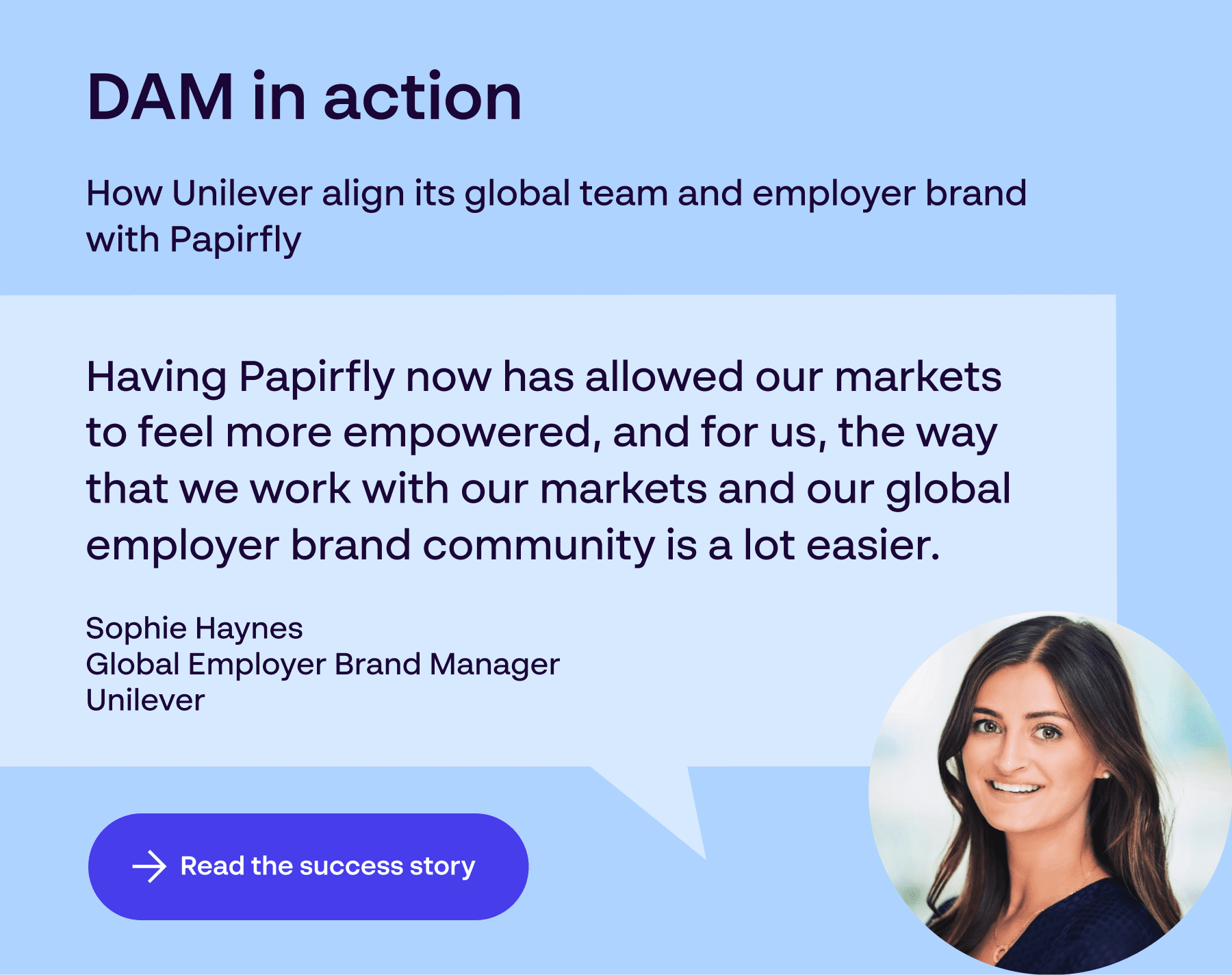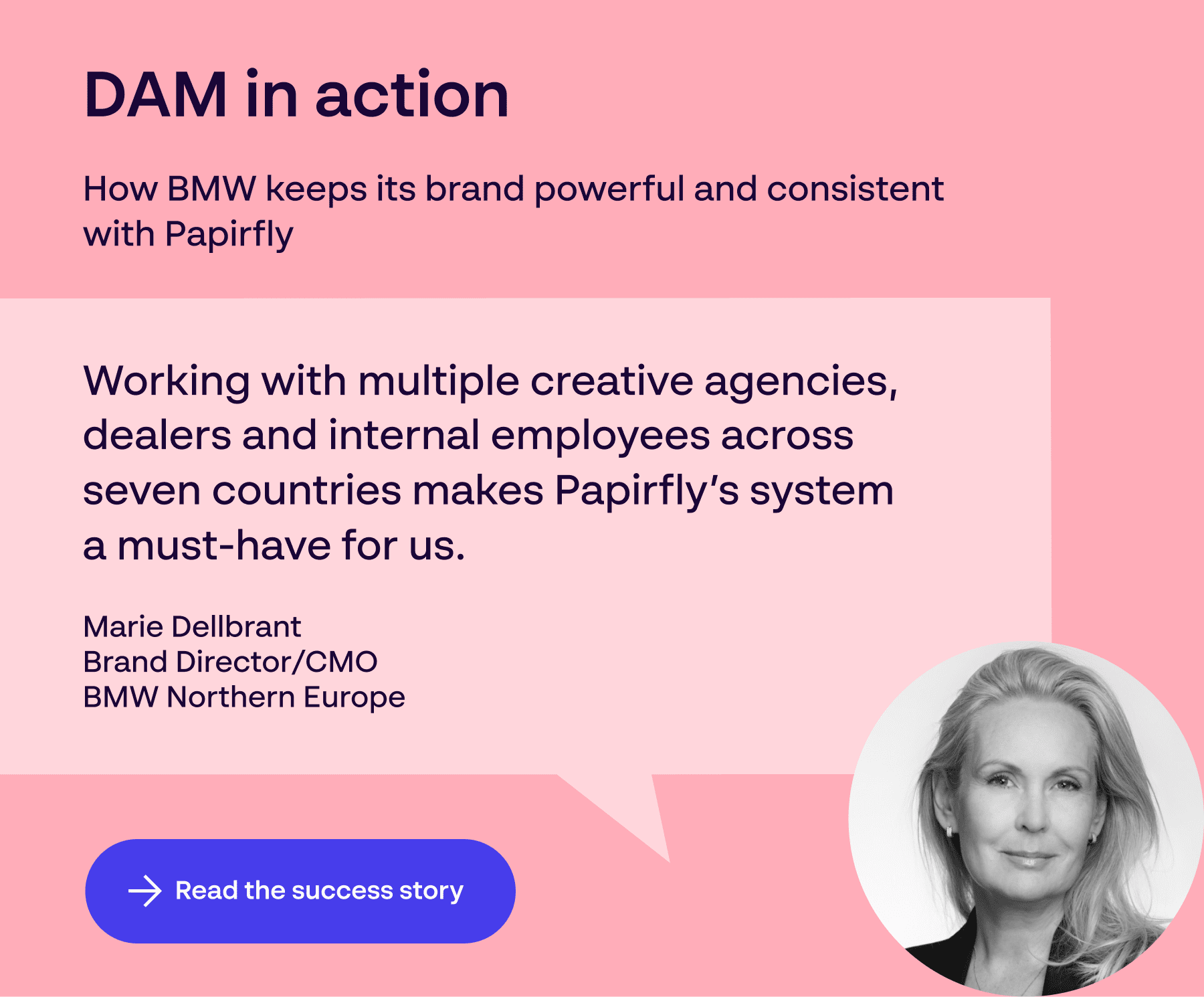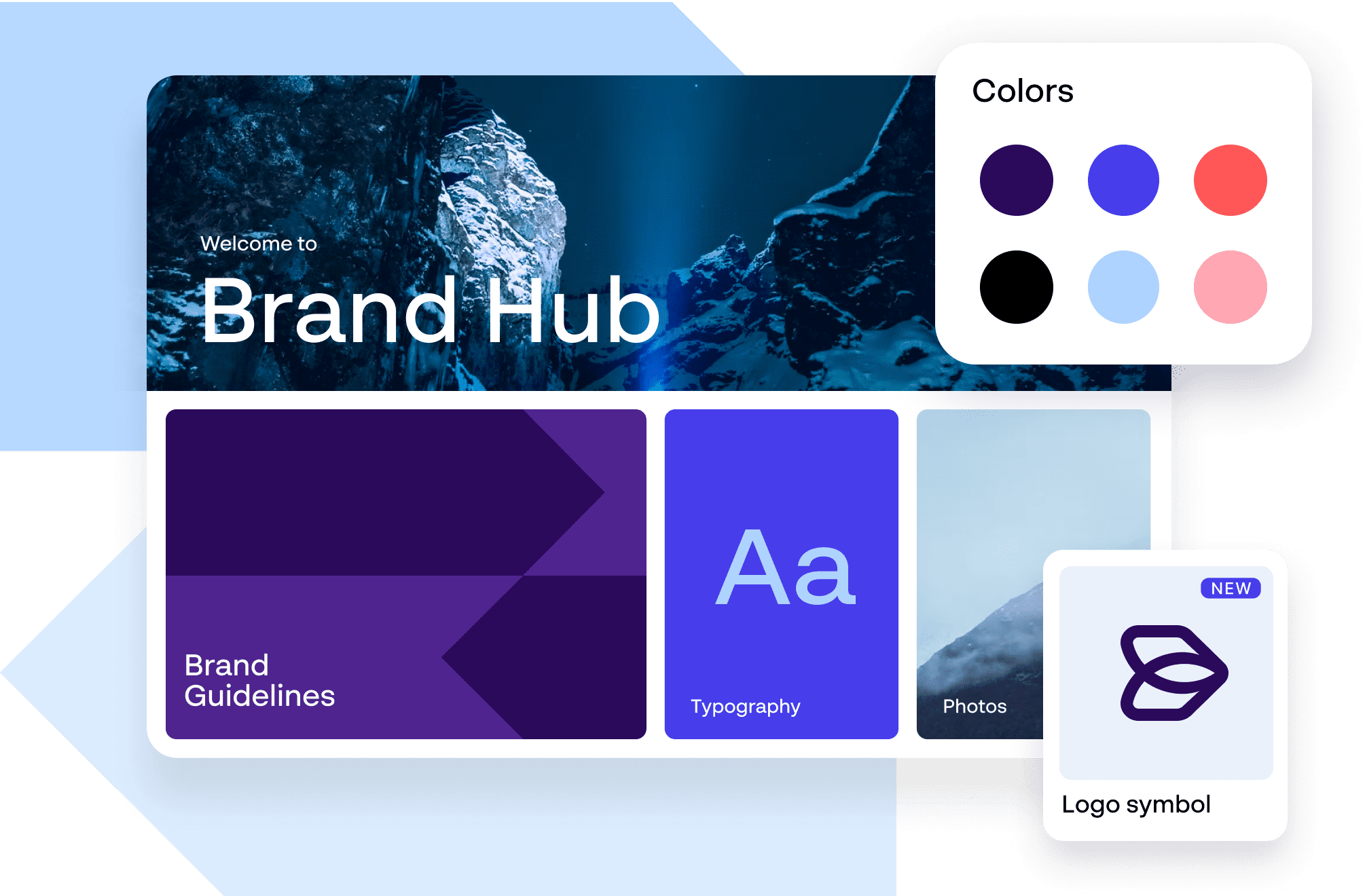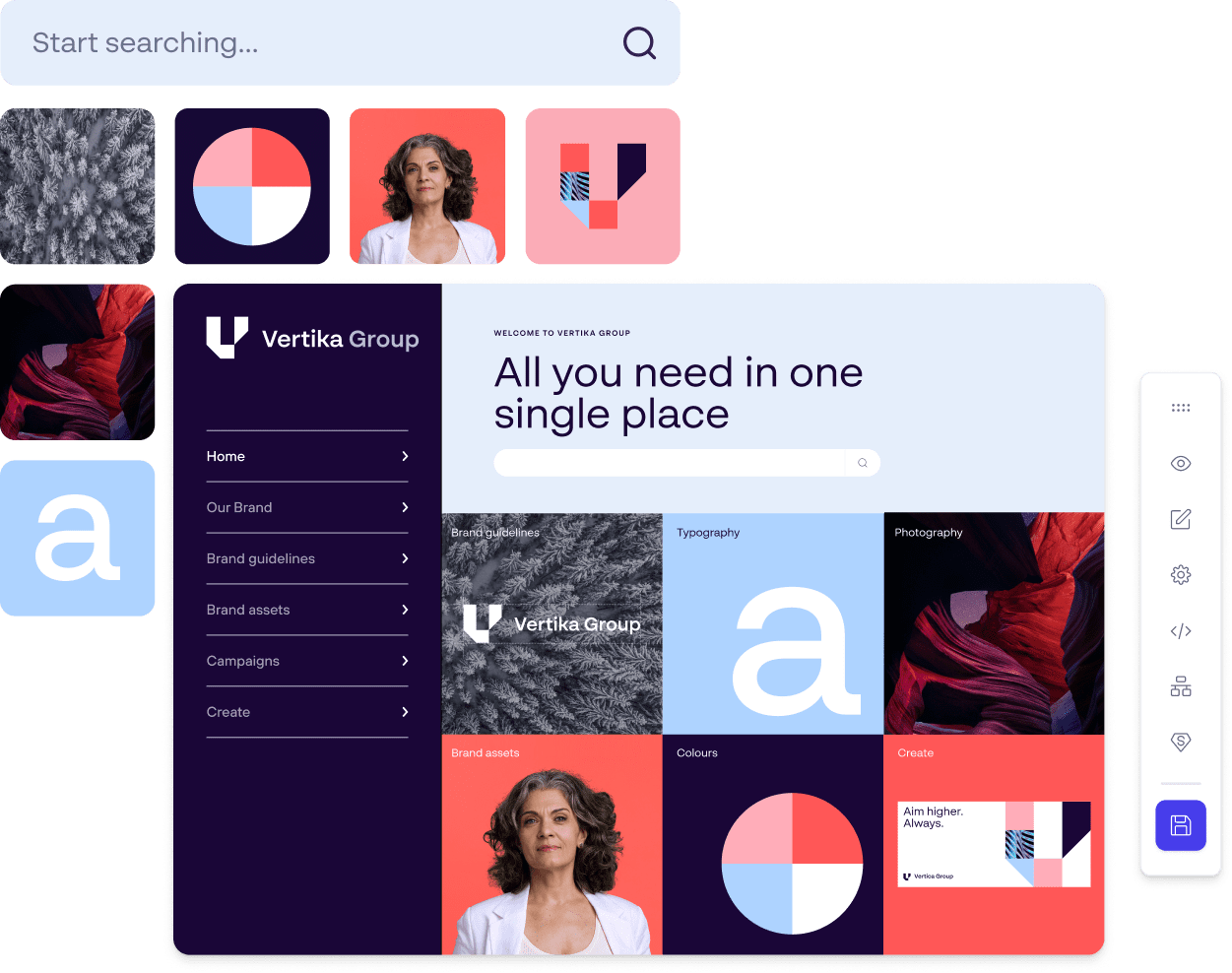If digital asset chaos is making your teams less productive and your brand less consistent, it’s time to look at Digital Asset Management (DAM). Our Digital Asset Management Guide is here with the full lowdown.
Discover how the best Digital Asset Management software can help you:
- Organize, protect, and scale content
- Streamline campaign execution
- Accelerate workflows and reduce bottlenecks
- Ensure brand-compliant assets every time
What is Digital Asset Management?
Digital Asset Management (DAM) is a structured and secure way of managing all your organization’s digital content. It eliminates the chaos of misplaced files, outdated visuals, and inconsistent messaging, delivering brand assets to your teams on a silver platter.
What are digital assets?
Digital assets are more than just files. They’re all the visual, audio, and design resources your business invests in creating – and which in turn create value for your business. From images to videos, campaign artwork to sales documents, every asset shapes how your organization looks and sounds. Managing them effectively protects your investment and your brand.

Files like images, video, audio, and artwork are digital assets. Anything you can use and combine to deliver strategic goals for your business. For example, by creating marketing collateral, employer branding materials, or ecommerce listings.
Why is Digital Asset Management important?
Your digital assets represent your intellectual property, creative investment, and brand identity. Without the right system, they’re vulnerable to loss, misuse, and inefficiency. And that puts your investment – and your reputation – in jeopardy.
With DAM, assets are securely stored and easily accessible, so everyone uses them correctly every time. Result: faster workflows, stronger governance, and greater brand equity.
What does DAM software do?
A DAM platform provides a single, centralized location to store, organize, and share your brand’s digital files. It replaces fragmented systems – like shared drives or departmental folders – with one intelligent hub built for marketing operations.
Key features include:
- • Centralization for easy access across teams and regions
- • Metadata and taxonomy for powerful search and discovery
- • Permission controls to protect sensitive assets
- • Workflow automation to accelerate review and approval processes
Four types of software for Digital Asset Management
Digital Asset Management software comes in several forms, each suited to different business needs and technical setups. Here’s how to tell them apart.
1. On-premise DAM
An on-premise DAM is software that you manage in-house and that’s installed in your organization’s IT infrastructure. You maintain full control over the system, handling updates, security, and performance internally. It puts a lot of responsibility on your shoulders, but can be beneficial for organizations with strict compliance requirements.
2. Cloud-based DAM
A cloud-based DAM (or cloud DAM) is hosted and managed by the software provider. You access it securely through the internet, while your vendor is responsible for all upgrades and maintenance – ideal for teams looking for flexibility and easy scalability. (We compare on-premise and cloud-based DAMs in more detail below.)
3. Enterprise DAM
An enterprise DAM is built for large, complex organizations that need advanced scalability and global brand governance. These systems typically include enhanced digital asset storage, global permissions, and localized support for multiple regions or teams. While the core functionality mirrors standard DAM systems, enterprise versions are optimized for performance and control at scale.
4. Headless DAM
A headless DAM is designed to operate quietly behind the scenes. It does not have a front end for accessing and managing digital assets but instead connects directly with other business systems, like Product Information Management (PIM), ecommerce platforms, or content delivery networks.
Why Digital Asset Management matters more than ever
Here are four key trends that are prompting modern businesses to switch to Digital Asset Management systems.
1. Demand for digital content has skyrocketed
From websites and social channels to intranets, third-party platforms, and traditional print – brands are producing more content in more formats than ever before. Without an intelligent way to organize and categorize assets, it’s easy for teams to lose track, duplicate work, or dilute the brand.
A global Digital Asset Management system brings structure to multichannel content creation, so your teams stay productive and your brand stays consistent.
2. Remote work and collaboration have become standard
It is now common for global teams, freelancers, and partners to collaborate across time zones – and they can only do so effectively if they have easy access to the same assets.
A cloud-based DAM enables exactly that. Teams can find, share, and update approved materials anytime, without compromising compliance or version control.
3. Competition for people’s attention is getting fiercer
Digital content is exploding while attention spans shrink. In this world, you only have a few seconds to make an impact on consumers – and consistency and recognizability are two of your greatest brand assets.
DAM acts as your brand consistency software, giving every employee access to approved visuals, templates, and guidelines.
4. Cyber threats are growing more frequent and sophisticated
DAM platforms are built with encryption, permissions, and audit trails to keep digital assets protected. Teams have full control over who can access, edit, or share files.

Six essential features of Digital Asset Management – and how they benefit your business
1. Centralization and organization – one home for every asset
A DAM system serves as a single, centralized digital asset library. Instead of files being scattered across drives, inboxes, and third-party platforms, everything lives in one secure, searchable location. Automatic version control ensures everyone is working with the latest file. Built-in audit trails capture every edit and approval.
Key benefits: Control brand assets, eliminate duplication, and reduce usage errors.
2. Search and discoverability – find what you need, fast
What use is a digital asset library software if nobody can find their way around it? DAM uses metadata, taxonomy, and visual search to make every asset instantly discoverable.
Metadata adds context so assets can be found through multiple search routes – for example through product names, campaign tags, regions, or usage rights. Taxonomy gives your library logical structure. Visual thumbnails make searching easier by allowing users to preview files at a glance.
Key benefits: Boost productivity by saving many wasted hours spent searching for the right file.
3. Security and sharing – protect and control your brand’s IP
Brand assets are valuable intellectual property – and DAM protects them accordingly.
Granular permission controls ensure only authorized users can view, download, or edit specific assets. Encryption safeguards data in transit and at rest, while secure link sharing replaces risky transfers and expired downloads.
Key benefits: Ensure assets can be accessed by the right people – and only the right people.
4. Brand compliance, GDPR and regulatory obligations
Beyond security and sharing, a DAM plays a vital role in maintaining brand and regulatory compliance. With privacy laws and advertising standards tightening worldwide, brands need centralised control over how assets are stored, accessed and used.
By embedding consent information, expiry dates and usage rights directly into asset metadata, a DAM ensures teams only use approved, compliant content. Automated restrictions prevent expired or unlicensed materials from being published, while detailed audit trails capture every action for complete transparency.
Benefit: Reduce regulatory risk, ensure DAM GDPR compliance, and maintain customer trust through controlled, compliant asset management.
5. Collaboration and automation – work smarter, not harder
Today’s DAM systems are built for collaboration. Cloud-based access connects internal teams, agencies, and freelancers, enabling real-time feedback and faster approvals across time zones.
Automation features take efficiency even further. From AI-assisted tagging and automatic file conversions to fully automated workflows for publishing content, DAM removes repetitive manual work so your teams can focus on creativity and strategy.
Benefit: Enable seamless collaboration, reduce bottlenecks, and speed up time to market for every campaign.
6. Analytics – insight that drives smarter decisions
DAM analytics reveal which files perform best, who’s using them, and where gaps exist. This allows you to make data-driven decisions about future content investment and creation.
Benefit: Get clear visibility into asset performance, so you can continuously optimize your brand strategy and content spend.

Integrations – connecting your DAM to the tools that power your brand
Virtually any system that needs access to digital assets can integrate with your DAM – and your DAM can feed images, video, documents, and data directly to that system. Here are four of the most common types of DAM integration:
DAM + CMS
Integrating DAM with your CMS gives web editors advanced search and filtering tools – so they can quickly find the perfect assets to bring your website to life.
DAM + design software
Enable designers to browse, drag, and drop approved visuals directly from your DAM – without having to leave the window they’re working in.
DAM + PIM
Using a Product Information Management (PIM) system? Linking DAM and PIM lets you automatically pull product images into catalogs and ecommerce platforms, accelerating time to market.
DAM + CRM
Integrating with your Customer Relationship Management system allows teams to create brand-compliant assets faster, with content being automatically formatted for each channel.
Who uses DAM systems?
Marketing
Marketers use DAM to centralize, organize and categorize assets, ensuring everyone involved in campaigns can collaborate efficiently. Marketing asset management software gives creatives access to up-to-date assets and artwork, allows for rapid distribution to end users, makes it easier to manage event collateral, and enables you to automate workflows.
Creative agencies
Agencies use DAM to streamline and accelerate production processes and to protect and manage assets for different customers. Some even offer DAM services to customers as an additional revenue stream. Learn more about digital asset management for agencies
Content creators
For publishers and content creators, speed and accuracy are everything. A DAM provides a central hub to store, tag, and retrieve written, visual, and multimedia assets instantly.
Ecommerce and retail
Consumers buy with their eyes. By organizing product images, videos, and marketing visuals in a DAM, ecommerce and retail teams can ensure accurate, consistent, and high-quality presentation across websites, marketplaces, and campaigns.
Employer brands
DAM provides an employer branding platform for teams to manage recruitment campaigns and materials in one centralized asset library. It ensures every message, visual, and video reflects your company’s culture and helps create a unified candidate experience while also acting as an internal communications management tool.
Corporate brands
Consistency builds trust — and trust drives growth. That’s why corporate brands use DAM. By providing a single source of truth for brand guidelines, logos, templates, and visual assets, the system empowers people to represent the brand accurately, wherever they operate.
Make sure the right people access the right assets
Create bespoke hubs for your teams.
Make sure the right people access
the right assets
Create bespoke hubs
for your teams.
Create bespoke hubs for your teams.

When is the right time to invest in Digital Asset Management?
Every organization reaches a point when managing digital assets manually is no longer sustainable – and when a DAM goes from being a “nice to have” to business-critical. Here are eight signs you may have reached that point.
1. Your systems are slowing your teams down
Disorganized files, outdated systems, and endless searching are draining productivity. A DAM centralizes all your digital assets in one secure, searchable place, so everyone can get what they need – fast.
2. You need to cut costs, without cutting corners
A DAM accelerates and automates workflows, helping you increase operational efficiency and save precious time.
3. Your assets need stronger protection
A DAM’s granular access permissions will help you ensure only authorized users can view, edit, or download assets.
4. Your brand consistency is slipping
By providing a central source for approved brand assets, logos, and guidelines, a DAM helps every department stay on-brand.
5. You have remote working issues
A cloud-based DAM allows freelancers, agencies, and teams to collaborate seamlessly from any location.
6. Your current digital asset storage systems can’t keep up
Switching to a DAM enables you to handle thousands (or even millions) of assets without slowing down. The DAM scales with you, no matter how complex your operations get.
7. You need to raise your content game
A DAM system will enable you to create, distribute, and publish higher-quality content – at speed and at scale.
8. You’re digitizing your processes
Putting DAM at the center of your digitization strategy creates a foundation for smarter, faster, more connected operations.
The business case for Digital Asset Management
From reducing costs to accelerating go-to-market speed, DAM delivers benefits you can quantify and scale. Here’s how it pays off:
1. Greater operational efficiency
DAM streamlines processes across the board – from automating repetitive tasks like image resizing and file conversions to enabling seamless collaboration between global teams. No more duplicated effort, lost files, or “where’s the latest version?” messages. Everything lives in one organized, searchable system, ensuring assets move quickly from creation to delivery.
The impact: Accelerated digital asset management workflow, fewer manual interventions, and campaigns that launch on time and on brand.
2. Smarter resource optimization
DAM eliminates inefficiencies by giving teams instant access to approved assets. That means creatives spend more time creating, marketers spend more time strategizing, and every contributor focuses on work that drives business growth.
The impact: Greater productivity, higher engagement, and stronger returns from every role in your marketing, internal communications, and brand ecosystem.
3. Tangible cost savings
DAM doesn’t just help you achieve time and efficiency gains – it also directly reduces operational spend. For example:
- Team members can find and repurpose existing assets, so they don’t have to create them from scratch
- Enhanced visibility into your asset stock reduces the risk of duplicated work or purchases
- DAM minimizes your risk of costly legal exposure
The impact: Real savings, reduced waste, and smarter reinvestment in content that performs.
The ROI of Digital Asset Management
Based on typical deployment and usage patterns, an average Papirfly customer achieves:
- 212% Return on Investment (ROI)
- $1.17 million Net Present Value (NPV)
- 80% reduction in effort required for asset creation
- $200 average agency spend avoided per asset
- Payback period: under six months
Understanding the costs
We’ve included some typical DAM costs below. When planning your investment, it’s important to weigh these up against the cost of not having a DAM. How much time and money will your organization continue to lose by having disorganized assets?
- Upfront costs – Mostly just for on-premise licenses and infrastructure setup
- Subscription fees – Cloud-based models usually charge per user per month
- Storage – Additional fees may apply for higher volumes
- Number of assets – Some pricing models consider how many assets you need to store
- Features and customization – Some advanced capabilities, customizations or integrations may incur extra cost
- Maintenance and support – You may need to pay a monthly fee for technical support and training
- Migration – You may choose to pay the vendor or a third-party to migrate your assets to the new DAM
- In-house costs – Don’t forget to factor in-house costs like the time it will take to research and implement the system
How to choose and implement a DAM system
Selecting a DAM system is a major decision that should not be rushed. Here are some pointers to help you make the right choice – and make it count.
1. Define your requirements
DAM works best when it serves the whole organization, not isolated departments. Identify who will use the system, how they’ll use it, and what challenges it needs to solve.
Ask key questions:
- What goals will the DAM support?
- What types and volumes of assets will it manage?
- Which workflows need automation?
- Which existing systems (CMS, CRM, PIM, etc.) must it integrate with?
2. Research your options
With hundreds of DAM platforms available, research is essential. Don’t just rely on paid ads or surface-level comparisons. Instead:
- Look for vendors with proven success in your industry.
- Read independent analyst reports like The Forrester Wave™.
- Check user reviews on trusted sites such as G2 or Capterra.
And remember – the best DAM for your organization isn’t necessarily the most expensive. It’s the one that fits your processes, culture, and future vision.
3. Test and compare
Once you’ve narrowed your list, arrange product demos and hands-on trials. Compare each system against your requirements document. Assess usability, performance, and overall fit for your teams.
You should also invite key stakeholders to join the demo sessions. Their input will ensure the system you choose supports every corner of your organization.
Secure the right DAM
for your organization
Learn how to navigate
the buying journey.
Secure the right DAM for your organization
Learn how to navigate
the buying journey.
Secure the right DAM for your organization
Learn how to navigate
the buying journey.
What to look for in a DAM platform
Beyond pricing and features, key elements to consider when assessing potential DAM solutions include:
Functionality
Start with the essentials: centralized storage, advanced search and filtering, permissions, and asset version control. Then look at more sophisticated capabilities such as automation, templating, and AI-assisted tagging. If you need your DAM to double as brand portal software or to connect with ecommerce systems, ensure those features are built in, not bolted on.
Scalability
DAM scalability is critical. Look for a solution that will effortlessly expand as your teams, regions, and content volumes grow. You should be able to add users, storage, and integrations without disrupting operations or budgets.
User experience
Even the most powerful DAM won’t deliver ROI if people don’t use it. The interface must be intuitive, visually clear, and easy to navigate. A good user experience encourages adoption and helps teams make the system part of their daily routine.
Integrations
A DAM should fit seamlessly into your existing tech ecosystem. Look for integrations with your CMS, design tools, CRM, or PIM systems to connect workflows and prevent duplication. This ensures assets flow smoothly between teams and channels.
Vendor support
Strong vendor support makes all the difference during setup and beyond. Ask about onboarding, self-service resources, and response times for technical issues. You want a partner – not just a provider.
Not sure what to look for in a DAM?
We’ve got you covered
Not sure what to look for in a DAM?
We’ve got you covered.
Not sure what to look for in a DAM?
We’ve got you covered.

On‑premise vs cloud‑based DAM
Which is better? It all depends on how much control you need – and how much responsibility you’re willing to take on. Here’s a snapshot of how the two models compare:
| On-premise DAM | Cloud-based DAM | |
|---|---|---|
| Access | Restricted access | Anywhere access |
| Scalability | Limited by your in‑house storage capacity | In theory, unlimited storage, but with costs attached |
| Maintenance and updates | You are responsible for upgrades and maintaining the system | The provider is responsible for upgrades and maintaining the system |
| Security and control | Direct, maximum control | Reliant on provider |
| Customization | Customization options via your in‑house team – maximum flexibility but limited by IT capacity | Some customization usually availability via support request – may incur additional cost |
| Integrations | Via your in‑house team | Some available out‑of‑the‑box and others via your own team using APIs |
| Upfront costs | Bigger upfront costs – you buy the platform outright | Lower upfront costs – you buy subscriptions (seats) |
| Deployment | Slower due to need for infrastructure set up | Faster as minimal infrastructure needed – simply deployed online |
| Data sovereignty | Greater control over geographic location and data sovereignty | Less control over geographic location and data sovereignty |
Access
On-premise DAM:
Restricted access
Cloud-based DAM:
Anywhere access
Scalability
On-premise DAM:
Limited by your in-house storage capacity
Cloud-based DAM:
In theory, unlimited storage, but with costs attached
Maintenance and updates
On-premise DAM:
You are responsible for upgrades and maintaining the system
Cloud-based DAM:
The provider is responsible for upgrades and maintaining the system
Security and control
On-premise DAM:
Direct, maximum control
Cloud-based DAM:
Reliant on provider
Integrations
On-premise DAM:
Via your in-house team
Cloud-based DAM:
Some available out-of-the-box and others via your own team using APIs
Deployment
On-premise DAM:
Slower due to need for infrastructure set up
Cloud-based DAM:
Faster as minimal infrastructure needed – simply deployed online
Five best practices for Digital Asset Management
Implementing a Digital Asset Management (DAM) system is a big deal for your organization – a cultural shift in how everyone creates, manages, and protects content. Following these proven best practices will help you get the most out of your investment.
1. Be strategic from the start
Your DAM initiative should directly support your wider business goals. Whether you’re focused on improving efficiency, enhancing collaboration, maintaining brand consistency, or driving digital transformation, use your objectives to guide every stage of implementation.
2. Audit your assets and workflows
Your DAM provider will have a LOT of questions. Come prepared with knowledge of how many assets you have, where they live, how they’re used, and who needs access to them, as well as information on file types and workflows.
3. Don’t just replicate – innovate
This isn’t about digitizing the status quo. It’s about creating the kind of system you’d love to have. Speak with the teams who create, approve, and distribute content. What challenges do they have? Where do bottlenecks occur? What could be improved? You should also ask your DAM vendor how other customers use the software to see if there are any innovations you could adopt.
4. Plan for onboarding and training
However intuitive your new DAM system, users will still need training and support to use it effectively. Requirements will vary between user groups. For example, admins are likely to need hands-on workshops while casual users should be able to learn through video tutorials or quick-start guides. Create a communication and training plan to help you roll out your new software and get people excited about using it.
5. Commit to long‑term governance
Without regular maintenance, even the best-designed system can become cluttered and inefficient. Establish clear governance practices – and if your asset library is extensive, consider appointing a DAM manager or librarian. Their responsibilities should include:
- Archiving outdated or redundant assets
- Reviewing metadata and taxonomy for accuracy
- Managing user access and permissions
- Overseeing security and software updates
- Monitoring usage and optimizing performance
The future of AI‑powered Digital Asset Management
DAM systems speed up manual, time-consuming processes – and, with intelligent automation, they’re doing it faster than ever. Here are three ways that AI is shaping the next generation of Digital Asset Management.
1. Smarter metadata through AI auto‑tagging
Modern DAM systems handle one of the most important yet repetitive asset management tasks automatically via AI metadata tagging. AI asset management software can instantly recognize an image, video, or document and apply meaningful tags that describe its content, even during bulk uploads of thousands of files.
The impact: Faster uploads, consistent metadata, and a stronger foundation for content discovery.
2. AI-powered search and recommendations
Search within DAM is evolving from reactive to predictive. AI algorithms now analyze user behavior – from search patterns to content engagement – to deliver smarter, personalized recommendations. Instead of typing in the perfect keyword, users are guided to the assets most relevant to their role, project, or past activity. This means less searching, more discovering, and far greater productivity.
The impact: Assets find you – not the other way around.
3. Generative AI within DAM
Generative AI is the next frontier. While some DAM systems already use it to make light edits, the technology is rapidly expanding in scope. Soon, users will be able to create new assets directly within their DAM environment. Imagine using a brand video maker or image generator to generate campaign variations and localized content in seconds.
The impact: A future where DAM doesn’t just manage content – it helps create it.
Beyond this Digital Asset Management guide – take control!
If digital asset chaos and constant approval bottlenecks are slowing your organization down, a next-generation DAM like Papirfly could be the solution. Organize and showcase your brand, create content on-demand, and scale global governance.
Take the next step on your DAM journey
Discover how Papirfly helps brands manage and scale content.
Take the next step on your DAM journey
Discover how Papirfly helps brands manage and scale content.
Take the next step on your DAM journey

Table of contents:
- What is Digital Asset Management?
- Why is Digital Asset Management important?
- What does DAM software do?
- Four types of software for Digital Asset Management
- Why Digital Asset Management matters more than ever
- Five essential features of Digital Asset Management – and how they benefit your business
- Integrations – connecting your DAM to the tools that power your brand
- Who uses DAM systems?
- When is the right time to invest in Digital Asset Management?
- The business case for Digital Asset Management
- The ROI of Digital Asset Management
- How to choose and implement a DAM system
- What to look for in a DAM platform
- On‑premise vs cloud‑based DAM
- Five best practices for Digital Asset Management
- The future of AI-powered Digital Asset Management


